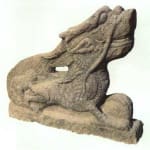Large Sculpture Of A Dragon, 960 CE - 1279 CE
Granite
45.25
H.524
As a symbol of vigilance and safeguard, the dragon was chosen among the auspicious creatures to be carved from large boulders hauled in from mountainous regions during the Sung Dynasty....
As a symbol of vigilance and safeguard, the dragon was chosen among the auspicious creatures to be carved from large boulders hauled in from mountainous regions during the Sung Dynasty. The positive energy of the rock was believed to endow these creatures the power force of immortality. This stone dragon raises its head toward the heavens, but remains watchful of the earth through its keen sense of sight. Piercing eyes bulge out from eyebrows of fire. Flaring nostrils and clinching teeth, the dragon seems to strain against the wind as his horns, ears, and spiked mane are pulled back. Its scaly body and uplifted tail indicate its relation to fish, as this type of dragon is known to reside in marshes and dens in the mountains. Stone carving became an essential feature of tomb complexes as the above ground complex began to add monumental gates and pavilions as wells as offering halls and temples. Stone was used as in other buildings such as palaces and temples, for ceremonial gateways, balustrades and stairways. However, tombs attracted special categories of sculpture: pillars at the entrances and large carvings of animals and men. Auspicious animals were recreated in stone and placed on mounds, as it was believed that, as inhabitants of the exotic dwellings of spirits in distant mountainous lands, they would come to life.
Literature
V17



